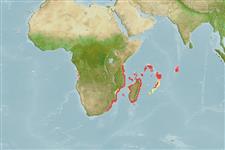Elasmobranchii (haaien en roggen) (sharks and rays) >
Squatiniformes (Angel sharks) >
Squatinidae (Angel sharks)
Etymology: Squatina: Latin for skate, which angel sharks superficially resemble, presumably tautonymous with Squalus squatina Linnaeus 1758 (no species mentioned). (See ETYFish); africana: ana- (L.), belonging to: Africa, referring to distribution from South Africa to Mozambique, Tanzania and Madagascar. (See ETYFish).
More on author: Regan.
Environment: milieu / climate zone / depth range / distribution range
Ecologie
marien demersaal; diepte ? - 494 m (Ref. 5578), usually 60 - 300 m (Ref. 5578). Subtropical; 4°S - 32°S
Western Indian Ocean: tropical and warm temperate waters from Tanzania to the eastern Cape coast of South Africa.
Lengte bij maturiteit / Grootte / Gewicht / Leeftijd
Maturity: Lm 91.5, range 90 - 93 cm
Max length : 84.0 cm TL mannelijk / geslacht onbekend; (Ref. 128961); 108.0 cm TL (female)
Korte beschrijving
Morfologie | Morfometrie
This medium-sized angel shark species (maximum size 122.0 or possibly 130.0 cm TL) posess the following characters: no median row of scute-like denticles on the trunk; anterior nasal flap has two lateral, elongate barbels and a medial rectangular barbel, the ventral margin of medial barbel is slightly fringed, but that of lateral barbels are almost smooth; posterior nasal flap without additional barblet; concave between eyes; pectoral-pelvic space 6.0-10.2% TL; pectoral-fin apex is angular; pelvic-fin free rear tips do not reach level of first dorsal-fin origin; tail moderately long, its length from cloaca 51.2-53.2% TL; pectoral fins are moderately long, length 31.8-35.6% TL; dorsal fins are not lobe-like; first dorsal-fin base is somewhat longer than second dorsal-fin base; caudal fin of adults with angular apices; monospondylous centra 46-49; diplosondylous precaudal centra 58-62; total precaudal centra 104-111; total vertebral centra 134-143; pectoral-fin skeleton is with propterygium articulating with three radials. Colouration: dorsal medium to dark brown, reddish-brown or grayish, with a variable pattern of numerous light and dark reddish spots and blotches, marbled with brownish reticulations and partially forming symmetrical dark bands or saddles (Ref. 128961).
Found on the continental shelf and uppermost slope, from the surf line close inshore to 494 m depth (Ref. 247). Feeds on bony fish, squid and octopus (Ref. 247). Ovoviviparous (Ref. 50449), with about 7 to 11 young in a litter (Ref. 247). Largest juvenile males measured with clearly immature claspers are 45.3 cm TL (ZMH 26100) and 50.3 cm TL (MNHN-IC-1987-1265) while the largest female examined is 94.0 cm TL (SAIAB 187381) and possibly an adult; while small female specimens of 29.3 cm TL (ZMMU P-14844), 30.9 cm TL (ZMH 123064), and 38.5 cm TL (MNHN-IC-1988-0359) mm TL are clearly juvenile (Ref. 128961). Sometimes caught by surf anglers (Ref. 6588).
Ovoviviparous, with about 7 to 11 young in a litter. Size at birth between 28 and 34 cm. Embryos feed solely on yolk (Ref. 50449).
Weigmann, S., D.F.B. Vaz, K.V. Akhilesh, R.H. Leeney and G.J.P. Naylor, 2023. Revision of the western Indian ocean angel sharks, genus Squatina (Squatiniformes, Squatinidae), with description of a new species and redescription of the African angel shark Squatina africana Regan, 1908. Biology 2023, 12(77):975. (Ref. 128961)
Status op de Rode Lijst van het IUCN (Ref. 130435)
Gevaar voor de mens
Traumatogenic
Gebruik door de mens
Visserij: visserij voor eigen gebruik; sportvis: ja
Meer informatie
Leeftijd/GrootteGroeiLengte-gewichtLengte-lengteLengtefrequentiesMorfometrieMorfologieLarvenLarvale populatiedynamiekRekruteringAbundantieBRUVS
ReferentiesAquacultuurAquacultuurprofielKweeklijnenGeneticaElectrophoresesErfelijkheidZiektesVerwerkingNutrientsMassaconversie
Tools
Speciale rapporten
Download XML
Internetbronnen
Estimates based on models
Preferred temperature (Ref.
123201): 14 - 24.8, mean 18.2 °C (based on 68 cells).
Fylogenetische diversiteitsindex (Ref.
82804): PD
50 = 0.5000 [Uniqueness, from 0.5 = low to 2.0 = high].
Bayesian length-weight: a=0.00479 (0.00258 - 0.00888), b=3.03 (2.86 - 3.20), in cm total length, based on LWR estimates for this species & Genus-body shape (Ref.
93245).
Trofisch niveau (Ref.
69278): 4.2 ±0.5 se; based on diet studies.
Weerstandsvermogen (Ref.
120179): Zeer laag, minimale populatieverdubbelingstijd meer dan 14 jaar (Fec=7).
Fishing Vulnerability (Ref.
59153): High vulnerability (65 of 100).
